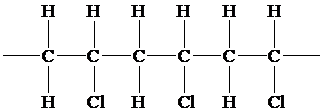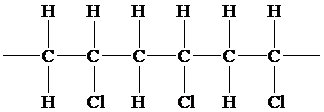
Concept explainers
Interpretation:
The Lewis structure of vinyl chloride, repeating units of vinyl chloride, and the enthalpy change are to be calculated.
Concept Introduction:
The standard enthalpy for a reaction is the amount of enthalpy change that occurs to occur understandard conditions(room temperature and pressure)
The enthalpy of reaction can be calculated as:
Here, BE represents the average value of bond enthalpy.
Answer to Problem 128AP
Solution:
(a)

(b)

(c)
Explanation of Solution
a)The Lewis structure of vinyl chloride
There are a total of 18 electrons in
The skeletal structure for

The Lewis structure for

b)Draw a portion of the molecule showing three
The poly vinyl chloride has the repeating chain of
The portion of poly vinyl chloride for three repeating chain of

Given information:
Mass,
c) The enthalpy change when
The molar mass of vinyl chloride is
The moles of vinyl chloride can be calculated as:
Substitute
The enthalpy of reaction can be calculated as:
From table 8.6, the enthalpy of formation values are:
Now, the standard enthalpy of a given reaction is:
Substitute,
The heat released is
Substitute
Hence, the enthalpy change is
Want to see more full solutions like this?
Chapter 8 Solutions
Chemistry
- Given the bonds C N, C H, C Br, and S O, (a) which atom in each is the more electronegative? (b) which of these bonds is the most polar?arrow_forwardCyanic acid, HOCN, and isocyanic acid, HNCO, dissolve in water to yield the same anion on loss of H+. Q.) Write a Lewis structure for isocyanic acidarrow_forwardDraw Lewis structures of free radicals The ethyl radical, CH3¬ CH2arrow_forward
- The C¬O bond length in carbon monoxide, CO, is 1.13 Å, whereas the C¬Obond length in CO2 is 1.24 Å. Without drawing a Lewis structure, do you think thatCO contains a single, double, or triple bond?arrow_forwardThe molecular shape of TeCl4^2¯ is __?arrow_forwardDraw a valid Lewis structure for phosgene, CCl2O, which contains a central carbon atom.arrow_forward
- (a) Describe the molecule xenon trioxide, XeO3, using four possible Lewis structures, one each with zero, one, two, or three Xe—O double bonds. (b) Do any of these resonance structures satisfy the octet rule for every atom in the molecule? (c) Do any of the four Lewis structures have multiple resonance structures? If so, how many resonance structures do you find? (d) Which of the Lewis structures in (a) yields the most favorable formal charges for the molecule?arrow_forwardCarbon tetrachloride was formerly used in fire extinguishers for electrical fires. It is no longer used for this purpose because of the formation of the toxic gas phosgene, Cl2CO. Write the Lewis structures for carbon tetrachloride and phosgene.arrow_forwardWrite a Lewis structure for the amide ion, NH2─, and assign formal charges to each atom.arrow_forward
- Determine the number of valence electrons in (CH₃C(O)CN) and then draw the corresponding Lewis structure.arrow_forwardMethyl isocyanate, which was involved in the disaster inBhopal, India, in 1984, has the chemical formula CH3NCO.Draw its Lewis diagram, including resonance forms.(Note: The N atom is bonded to the two C atoms.)arrow_forward1. Draw the Lewis structure for H2O, CH4 (methane), and for NH3. 2. Write the Lewis structure of the following molecules: a. Ethylene, C2H4 b. Acetylene, C2H2 c. Carbon tetrachloride, CCl4 d. COBr2 (for the skeletal structure, C is bonded to O and Br atoms)arrow_forward
 Chemistry: Principles and ReactionsChemistryISBN:9781305079373Author:William L. Masterton, Cecile N. HurleyPublisher:Cengage Learning
Chemistry: Principles and ReactionsChemistryISBN:9781305079373Author:William L. Masterton, Cecile N. HurleyPublisher:Cengage Learning Chemistry: The Molecular ScienceChemistryISBN:9781285199047Author:John W. Moore, Conrad L. StanitskiPublisher:Cengage Learning
Chemistry: The Molecular ScienceChemistryISBN:9781285199047Author:John W. Moore, Conrad L. StanitskiPublisher:Cengage Learning Chemistry: Principles and PracticeChemistryISBN:9780534420123Author:Daniel L. Reger, Scott R. Goode, David W. Ball, Edward MercerPublisher:Cengage Learning
Chemistry: Principles and PracticeChemistryISBN:9780534420123Author:Daniel L. Reger, Scott R. Goode, David W. Ball, Edward MercerPublisher:Cengage Learning Chemistry & Chemical ReactivityChemistryISBN:9781133949640Author:John C. Kotz, Paul M. Treichel, John Townsend, David TreichelPublisher:Cengage Learning
Chemistry & Chemical ReactivityChemistryISBN:9781133949640Author:John C. Kotz, Paul M. Treichel, John Townsend, David TreichelPublisher:Cengage Learning



